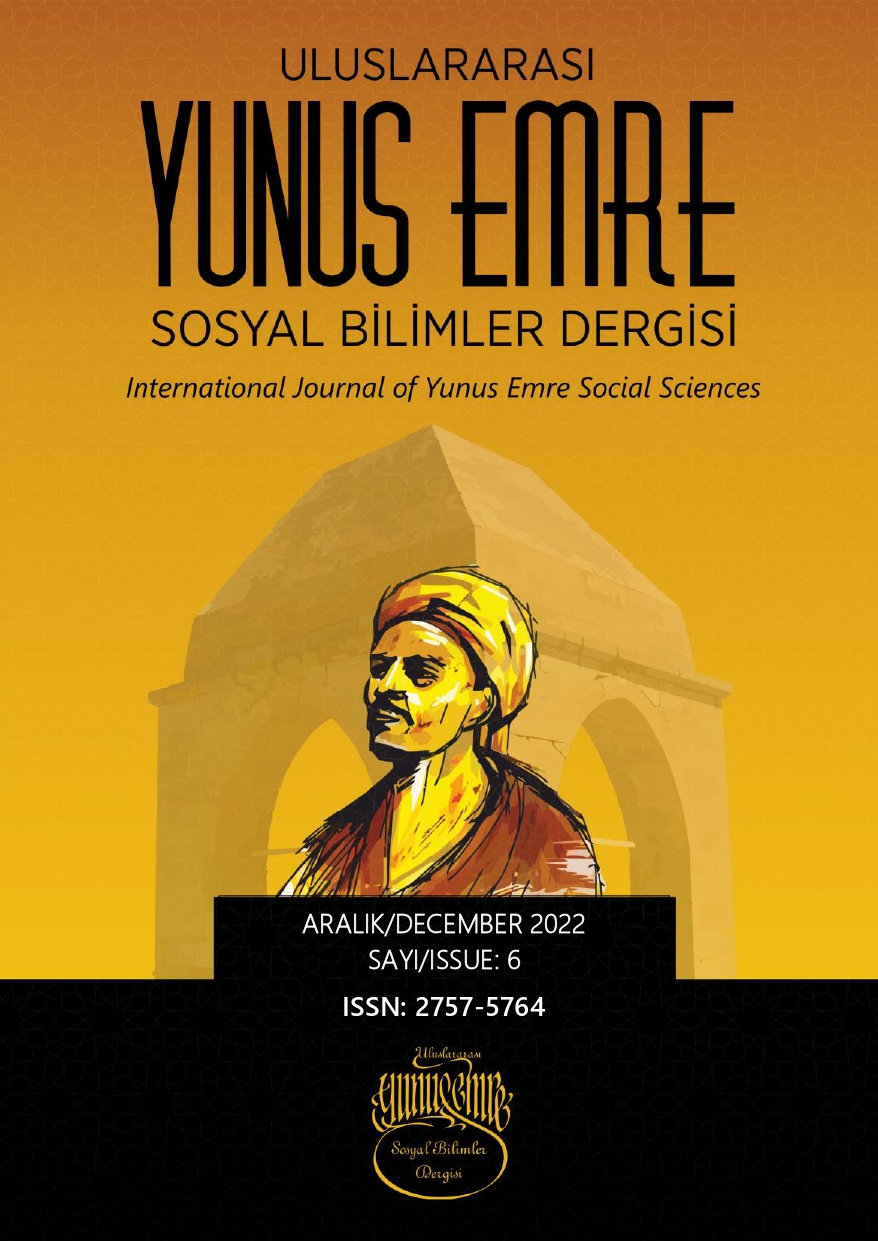HİKÂYE BAĞLAMINDA ALKIŞ VE KARGIŞLARIN SÖZ DİZİMİ VE KONULARI ÜZERİNE İNCELEMELER: ANTEKELİ DELİ HÖSÜN ÖRNEĞİ
Author :
Abstract
Alkış ve kargışlar, Türk sözlü kültür ürünleri içerisinde önemli bir yere sahiptir. Günümüzde dua ve beddua terimiyle de bilinen alkış ve kargışlar, kişilerin mutluluk ve mutsuzluklarını dışa vuruş şekilleriyle oluşmaktadır. Toplum içerisinde insanların yaşadıkları olaylar veya bu olayların anlatımında kullanmış oldukları kalıp sözler, toplumların maddi ve manevi değer yapısını ortaya koymaktadır. Alkış ve kargışlar zamana ve zemine göre değişik şekiller almıştır. Antakya yöresi de alkış ve kargış kullanımı bakımından farklı örneklere ulaşabileceğimiz bir veri sunmaktadır. Bu çalışmaya kaynaklık eden ‘‘Antekeli Deli Hösün’’ adlı kitap, yirmi dört kısa hikâyeden oluşmaktadır. Bu hikâyeler, Antakya merkez ağzı özellikleriyle yazılmış olup ayrıca yörenin zengin kültür özelliklerini de bünyesinde barındırmaktadır. Çalışmada hikâyeler içerisinde bulunan alkış ve kargışlar tespit edilerek incelenmiştir. Bu incelemeler, konu ve köken muhteviyatından oluşmaktadır. İncelemeler sonucunda bu kitapta kullanılan alkış ve kargışların hangi düşünce üzerinde söylendikleri belirlenmiş olacaktır. Ayrıca alkış ve kargışlarda kullanılan kelimelerin kökenlerini görmek mümkün hâle gelecektir.
Keywords
Abstract
Blessings and damnss have an important place in Turkish oral culture products. Blessings and damns, which is also known as prayer and curse today, is formed by the way people express their happiness and unhappiness. The events that people experience in the society or the stereotypes they use in the narration of these events reveal the material and spiritual value structure of the societies. Blessings and damns have taken different forms according to time and place. The Antakya region also presents data from which we can reach different examples in terms of the use of blessing and damn.The book named "Antekeli Deli Hösün", which is the source of this study, consists of twenty-four short stories. These stories were written with the features of the central dialect of Antakya and also contain the rich cultural features of the region. In the study, blessings and damns in the stories were determined and examined. These reviews consist of subject and origin content. As a result of the examinations, it will be determined on which idea the blessings and damns used in this book are said. In addition, it will be possible to see the origins of the words used in blessings and damns.
Keywords
- Artun, Erman (2011). Günümüz Adana Aşıklık Geleneğinde Alkış-Kargış. http://turkoloji.cu.edu.tr.
- Bayat, Fuzuli – Aliyeva Çınar, Minara (2008). Eski Türkçe Sözlük. İstanbul: Ötüken Neşriyat.
- Bulut, Serdar (2012). Anadolu Ağızlarında Kullanılan Kalıp Sözler ve Bu Kalıp Sözlerin Kullanım Özellikleri. Turkish Studies, C 7, S 4a, s. 1117-1155.
- Caferoğlu, Ahmet (2011). Eski Uygur Türkçesi Sözlüğü. Ankara: TDK Yayınları.
- Cengiz, Alim Koray - Güzelşemme, Neşe (2021). Antakya-Harbiye ve Samandağ Arapçasında Gündelik Dilde Kullanılan Kargışlar/Beddualar. Nüsha, C 21, S 52, s. 247-268.
- Devellioğlu, Ferit (2010). Osmanlıca-Türkçe Ansiklopedik Lûgat. Ankara: Aydın Kitabevi Yayınları.
- Düzgün, Dilaver (2002). Dede Korkut Kitabı’nda Alkışlar ve Kargışlar. Türkler Ansiklopedisi, Yeni Türkiye Yayınları, 3, s. 806-810.
- Gökdayı, Hürriyet (2008). Türkçede Kalıp Sözler. Bilig, S 44, s. 89-110.
- Gökyay, Orhan Şaik (2004). Dedem Korkut Kitabı. İstanbul: Milli Eğitim Bakanlığı Yayınları.
- Gülensoy, Tuncer (2018).Türkiye Türkçesindeki Türkçe Sözcüklerin Köken Bilgisi Sözlüğü. İstanbul: Bilge Kültür Sanat.
- Gündoğdu, Raşid - Niyazi Adıgüzel - Ebul Faruk Önal (2017). Kâmûs-ı Türkî. İstanbul: İdeal Yayınları.
- Harmancı, Meriç (2012). Dede Korkut Hikâyelerindeki Alkış ve Kargışlara İşlevsel Bir Yaklaşım. Kocaeli Üniversitesi Sosyal Bilimler Enstitüsü Dergisi, S 23, s. 1-17.
- Haşimi, Ahmet (2020). Hatay Ağzında Hâl Eklerinin Farklı Kullanımları Üzerine Bir Değerlendirme. Mustafa Kemal Üniversitesi Sosyal Bilimler Enstitüsü Dergisi. C 17, S 46, s. 449-480.
- Hatır maddesi (Erişim tarihi: 22.11.2022). http://lugatim.com/s/hatır
- Karahan, Leyla (1996). Anadolu Ağızlarının Sınıflandırması. Ankara: TDK Yayınları.
- Kâşgârlı Mahmud (2006). Divanü Lûgat’i-Türk. (Haz. Besim Atalay), 4. Cilt. Ankara: TDK Yay.
- Kaya, Doğan (1997). Dualar ve Beddualar. Türklük Bilimi Araştırmaları, S 4, s. 99-121.
- Kör maddesi (Erişim tarihi:22.11.2022). http://lugatim.com/s/kör
- Özön, Mustafa Nihat (2008). Osmanlıca-Türkçe Sözlük. Ankara: İnkılâp Kitabevi.
- Öztürk, Jale (2012). Antakya Ağzında Kargışlar. Prof. Dr. Mine Mengi Adına Türkoloji Sempozyumu Bildirileri kitabı içinde (s. 740-752). Çukurova Üniversitesi Sosyal Bilimler Enstitüsü.
- Öztürk, Jale (2013). Antakya Ağzında Alkışlar. Mustafa Kemal Üniversitesi Sosyal Bilimler Enstitüsü Dergisi, C 10, S 22, s. 1-19.
- Öztürk, Jale (2009). Hatay Ağzı. Adana: Karahan Kitabevi.
- Paçacıoğlu, Burhan (2016). Türkçenin VIII.-XVI. Yüzyıllar Arasında Sözcük Dağarcığı. İstanbul: Kesit
- Rahmet maddesi (Erişim tarihi: 22.11.2022). http://lugatim.com/s/rahmet
- Tanrıverdi, Mehmet (2018). Antekeli Deli Hösün. İstanbul: Hatay Keşif Yayınları.
- Tekin, Talat (2016). Orhon Türkçesi Grameri. Ankara: TDK Yay.
- Tietze, Andreas (2016). Tarihî ve Etimolojik Türkiye Türkçesi Lugati. Ankara: Tüba Yayını.
- Uysal, Yavuz (2019). Adıyaman Halk Kültüründe Dua ve Beddualar (Alkışlar-Kargışlar). Türkiyat Mecmuası. C 29, S 2, s. 621-644.
- Yusuf Has Hacip (1979). Kutadgu Bilig III. (Çev. Reşit Rahmeti Arat) İstanbul: Türk Kültürünü Araştırma Enstitüsü Yayınları.





